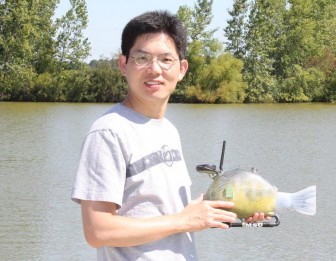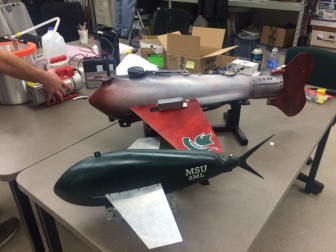
Dr. Xiaobo Tan Image: Michigan State University Department of Engineering
New and improved robot fish will soon track live fish and toxic algae blooms in the Great Lakes.
This next-generation fish, going on its second year of development, is the third model built by Xiaobo Tan, an associate professor in the Department of Electrical and Computer Engineering at Michigan State University, and his research team.
“We have a deadline right now to have two of these new ones done before summer, probably May,” said Cody Thon, a research assistant and a mechanical designer of the robot. “There is an algae problem every summer in Lake Erie so it would be wise to bring them out and see what they can do.”
One prototype is already getting tested at the university’s Kellogg Biological Station on the Wintergreen Lake, between Kalamazoo and Battle Creek, Michigan, Tan said.
“We were able to run the robot: Diving, swimming, going to certain spots, collecting data on harmful algae and temperatures, and send back that data to laptops,” he said
After successfully demonstrating the fish, Tan said he is confident that the next one will be ready to hit the Great Lakes.
“We would like to test it in Thunder Bay on Lake Huron,” he said. “We think it should be a relatively straightforward extension to be used in understanding and monitoring Lake Erie due to its depth.”
That’s important. Last year, Lake Erie algae blooms were so extreme that people in parts of Canada and Ohio were told not to drink the water. Algae blooms can produce toxins capable of causing illness, irritation and sometimes death in humans, livestock and pets.
The new robot will carry more sensors and allow researchers to more easily swap out parts of the fish for different applications. And they can more easily open the robot for maintenance, Tan said. It will also have an underwater acoustic antenna system so the robots can communicate with each other under water. That is critical for tracking fish.
Trailing fish to understand where they travel, find food and spawn is a new and unanticipated application.
“The project started as the fish being a platform for plugging sensors and a tool that scientists could use to test for anything they want in the water,” Thon said. “They can use these fish for anything from testing for harmful algae or crude oil to tracking schools of fish.”
The team has just recently started tracking live fish, tagging them with a surgically implanted acoustic device that sends a signal. The robots carry receivers that decode the signal and tell them where to swim.
“As we build these they have far more applications than we even perceived,” Thon said. “People are calling from all over the place, asking for us to track fish with sonar sensors.”

The first two generations of the robotic fish. Image: Danielle Woodward
Tracking fish is useful for both native and invasive species.
“If it’s invasive, such as sea lamprey, we want to control it and if it’s native, such as lake trout, we want to restore it,” Tan said. “To do this we need to understand where they travel, find food and spawn. When we know this we can construct habitats to aid or weaken their reproduction and development.”
Tan figures it will be three to four years for the robotic fish to be swimming the Great Lakes. The National Science Foundation has given $1 million in funding to the project.
The goal is for the robotic fish to become a commercial product for scientists to be able to carry around and use at their convenience, Thon said. This will most likely take more than another three years of development.
“We haven’t had one in a great lake yet,” Thon said. “It’s a big body of water with factors like underwater currents where a lot can happen to the robotic fish.”
Also in the future: solar panels for the fins, Thon said.
“That will be a big step because it would essentially allow you to keep the robots out there forever,” he said.